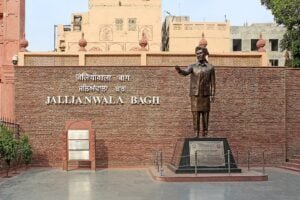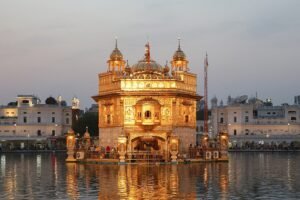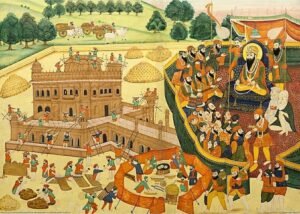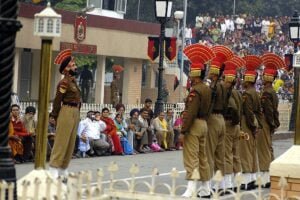No products in the cart.
AMRITSAR : A World Of Spiritual and Temporal Sustenance
Punjab
The multi-layered appeal of Punjab lies in the contrary, open-hearted, liberal landscape of its culture. Step off the train at Amritsar railway station and you are immediately enveloped by the bedlam of arrivals and departures. Yet, even in all this chaos, it is not unusual to find an elderly matron, calmly sitting atop her bundles and baggage deep in prayer, whispering incantations from the Holy Grant Sahib.
Wandering around the city it’s easy to discover how Amritsar so richly mirrors Punjab’s intertwining of the spiritual and the material worlds. From the beautiful gurudwaras to the eat streets, its ancient bazaars, and its mandis you can explore these twin worlds one of the most engaging cities in the north.
A compelling contrast to neat and clean Chandigarh, a new capital city aimed to project an image of modernity and progress, post-Independence, after the loss of Lahore envisioned by Jawahar lal Nehru and French architect Le Corbusier, Amritsar winds you back to its historic past in endless ways. From the olden- days cramped mohallas to the antique bazaars accessed by noodle-thin lanes, it’s a pulsating world of living traditions handed down from generation to generation.
Bowling along the wide avenues and squiggly by lanes abandon yourself to the vibrant sights and sounds of the city which was established in 1577 by the Sikh Guru Ram Das, and rose to become the pinnacle of industrial success and spiritual sanctity under the patronage of Maharaja Ranjit Singh. How adeptly the one-eyed maharaja played those war games with the British to hold on to this strategically located city.
Jallianwala Bagh 
All is still at the historic garden complex of Jallianwala Bagh the site of one of the most heinous acts of inhumanity that sullied the days of the Raj in India. Standing silently in the Garden of Sorrow, a memorial of National Importance, it’s hard to accept the hail of bullet marks that still pepper the high walls. A black day indeed, it was, when General R.E.H.Dyer’s troops unleashed volley after volley of bullets on the unarmed 20,000 men, women, and children who had gathered to peacefully protest the Rowlat Act which gave the English the license to imprison any Indian even remotely suspected of seditious acts. Punjab’s merciless summer heat has never been able to burn away the horror and the pain of that hideous event in Indian history.
Memories of Another Day
To delve deep into its history of survival against all odds you need to look beyond its superficial blandishments. Partition left its deepest scars here—but a visit to the Partition Museum, close to the Golden Temple, provides deeper insights into the city’s ability to rise above the pain of those years to the passion of living life to the fullest.
Spiritual Roots
Abandon yourself to the timeless atmospherics of the historic, spiritual, and temporal fount head of Sikhism – the Golden Temple. Open to people of all faiths it serves as one of the most alluring attractions of Punjab.
The Golden Temple marks the most enduring affirmations of Amritsar’s history and heritage. Guru Nanak in 1502 visited a sacred tank at this site located about 25 km from Lahore in undivided Punjab. Guru Amar Das Ji, the third Guru of Sikhs, is said to have come up with the idea of establishing a place of pilgrimage for the Sikh community. Ram Dass, his son-in-law who became the fourth Guru, began a village settlement here. Arjan Das, the fifth Guru conceived the idea of building a temple (Harmandir Sahib/ the Darbar Sahib) on a little island in the middle of the sacred Amrit Sarovar. Harmandir Sahib was consecrated on August 16, 1604, when the Adi Granth was first installed. The Akal Takht was built in 1606, and connected to the Harmandir by the causeway over the Amrit Sarovar. It was the nucleus for all secular matters and activities conducted by the gurus.
Baba Deep Singh’s shrine, which you’ll find on the southeast side of the tank, symbolizes the Baba’s defense of the Temple against Ahmed Shah Abdali. Maharaja Ranjit Singh rebuilt the temple after its destruction by Ahmed Shah Abdali and decorated it with loads of marble, copper, and gold leaf; it then came to be called the Golden Temple.
Join the stream of devotees paying their respects in the Harmandir Sahib or Sri Darbar Saheb Ji, with its two-storied sanctum where is enshrined the Shri Guru Granth Sahib Ji the Sikh Holy Scripture. Your calm parikrama around the Harmandir’s wraparound marble passage is accompanied by the soothing sounds of the Gurbani, recited 24/7 by the ragis.
Art and Architectural Refinements
The temple set in the centre of a 5.1 m deep pond, the Amrit Sarovar, is worthy of exploring for its architectural and spiritually symbolic decorative elements as well. Raised along Indo-Islamic- Mughal and the Hindu- Rajput architectural lines as noted by some scholars, the temple is a two-storied structure topped by a gold foiled dome. The inner sanctum with its marble flooring sprawls over a space of 12.25 x 12.25 sq m. The holy book is enshrined on the ground floor, where it rests under a bejwelled canopy. The second story of the sanctum is a pavilion called the Sheesh Mahal or Mirror Palace. Four open doors reflect the Gurus’ tenets that the Sikh religion is open to all, regardless of caste or creed.
The walls and ceilings of Sri Darbar Saheb Ji were originally awash with beautiful artworks rendered as the Mughal-style Mohra Kashi or fresco paintings. What you see today are paintings that are done over these original frescoes. The style of these is quite distinctive and represents the Sikh School of Mural Art. According to a descendent of Bhai Daya Singh one of the Guru Gobind Singhji’s Panj Piaras, Dr. Madanjit Kaur: “The most prominent of the variety of pattern categories is ‘Dehin’, a medium of expression of the imaginative study of the idealized forms. It has been borrowed extensively from Hindu and Muslim traditions but depicted them in their way and in a new setting” Dr. Madanjit Kaur is a distinguished historian and former professor in the Department of Guru Nanak Studies at Guru Nanak Dev University, Amritsar.
The artworks largely feature floral patterns interspersed with animal motifs. If you peer at the wall behind the northern narrow stairway leading to the top of the shrine, you’ll see the only fresco depicting human figures; it represents Guru Gobind Singhji on horseback. A Kangra artist was specially commissioned by Maharaja Ranjit Singh to add it to the Golden Temple collection of paintings. Look for ivory inlay work on the doors of the Darshani Deorhi.
Guru Granth Sahib Ceremonials
If you want to experience a unique ceremony at the temple, plan on attending the Sukhasna and Prakash ceremonies. Join devotees late at night when the Guru Granth Sahib is put to bed (Sukhasna or relaxed posture) in a wonderfully moving ceremony. Devotees feel twice blessed if they are permitted to lend a shoulder to the palanquin carrying the Granth Sahib from the Harmandir to the Akal Takht, where it is kept for the night in a special room called Sach Khand (Realm of Truth). If you miss that, you can opt for the early morning (Prakash, or ceremonial awakening of the Guru Granth Sahib) procession to the Harmandir Sahib. The ceremonials are symbolic of how the Guru Granth Sahib is treated like a living emperor and the Sikh devotees are the hands and feet of the Guru.
It is an incredible, truly memorable experience.
Langar Logic
Settling down cross—legged to partake of the daily langar discover the humanitarian world of community culture in Amritsar, even as you tuck into the most delicious homemade meals. The langar tradition is intrinsic to all voluntary gurudwara services for the community.
Foodie Haven
The city has its way of startling you with its incredible foody temptations any which way you turn. Chaat pakori for elevenses and pudina ka kanji to quench your thirst is just for starters .
The stupefying range of culinary offerings of the city will ensnare you for the freshness, flavour, and bonhomie of sharing. Wander through the maze of ancient streets and cobbled alleyways to indulge your taste buds with the perfect channa kulcha, legendary Amritsari fish, and makki ki roti. Ditch the Bond-perfect martinis and Singapore Slings and quaff down the legendary lassis and chilled beers like a true local.
Wagah Border
Revv up your patriotic fervour as you join the vast throngs at Wagah the border between India and Pakistan at Attari village. The grand Changing of the Guards ceremony, held around sunset is a high-octane affair conducted by India’s BSF (Border Security Force) and Pakistani Rangers.
Specials |
| You can sign up for the Amritsar Heritage Walk which covers many of the historic spots in the Old Quarter from Town Hall to the Gate of the Golden Temple.
|
ACCOMMODATION
The city offers accommodation for all budgets.
Access
Air: Amritsar’s Guru Ramdasjee International Airport.
Rail: Amritsar Junction, well-connected to Delhi, Mumbai and Kolkata. Both taxis and autos are easily available at the station
Road: Excellent interstate bus connectivity.
















